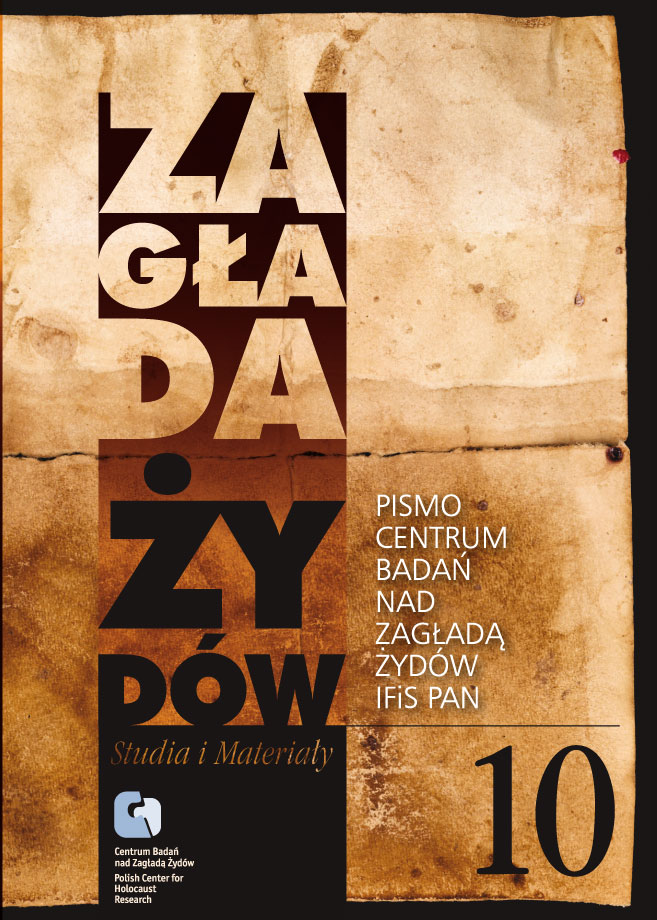Krzesiny i Kreising – między pamiętaniem a pomijaniem. Polskie miasteczko wobec historii, pamięci i rywalizacji w cierpieniu
Zagłada Żydów. Studia i Materiały, Nr 10 (2014), Strony: 443-461
Data zgłoszenia: 2020-10-22Data publikacji: 2014-12-01
 https://doi.org/10.32927/ZZSiM.532
https://doi.org/10.32927/ZZSiM.532
Abstrakt
The area around Krzesiny, located near the city of Poznań, Poland, witnessed several dark events during World War II: Germans oppressed the local population, culminating in a terrorizing action dubbed “akcja krzesińska;” also, a forced labor camp, named “Kreising,” was built near the township, housing mainly Jews. After the war, the suffering in Krzesiny was remembered, but selectively – “akcja” and other forms of Polish suffering were commemorated, while the camp was not. By exploring the “lieux de mémoire” in Krzesiny – dynamics of memory in a small township in Poland – this paper uses localized research to address the issue of gaps in collective memory and commemoration. We briefly look at the relevant history, Polish memory regarding wartime events in Krzesiny, and the postwar dynamics of collective memory. Discussing the latter, we identify a new phenomenon at work, one which we dub “collective disregard” – group neglect of the past of the “Other” that occurs without clear intent. We argue that “collective disregard” is an issue that naturally occurs in the dynamics of memory. By making a deliberate investment in balanced remembrance and commemoration, societies can counter the tendencies of “disregard” and curb the controversies of competitive victimization claims, also called “competitive martyrdom”.
Licencja
Prawa autorskie (c) 2014 Autor & "Zagłada Żydów. Studia i Materiały"

Utwór dostępny jest na licencji Creative Commons Uznanie autorstwa 4.0 Międzynarodowe.
https://creativecommons.org/licenses/by/4.0
Podobne artykuły
- Joanna Tokarska-Bakir, Sprawiedliwi niesprawiedliwi, niesprawiedliwi sprawiedliwi , Zagłada Żydów. Studia i Materiały: Nr 4 (2008)
- Nawojka Cieślińska-Lobkowicz, Centrum Dokumentacji Nazizmu w Monachium i obywatelska pamięć Niemiec , Zagłada Żydów. Studia i Materiały: Nr 12 (2016)
- Grzegorz Krzywiec, Derek Hastings, Catholicism and the Roots of Nazism: Religious Identity and National Socialism , Zagłada Żydów. Studia i Materiały: Nr 9 (2013)
- Agnieszka Pajączkowska, Obraz odzyskany. Fotograficzne portrety ocalonych , Zagłada Żydów. Studia i Materiały: Nr 4 (2008)
- Marta Tomczok, Po co dzisiaj jest Zagłada, czyli poetycki survival , Zagłada Żydów. Studia i Materiały: Nr 17 (2021)
- Mirosław Skrzypczyk, Robert Szuchta, Piotr Trojański, Holokaust. (Nie)odrobiona lekcja historii , Zagłada Żydów. Studia i Materiały: Nr 20 (2024)
- Jacek Leociak, “I don’t want people laughing at me for hiding Jews at my place . . .” The Case of Zdzisław and Halina Krzyczkowski , Zagłada Żydów. Studia i Materiały: 2010: Holocaust Studies and Materials
- Janusz Marszalec, Morderstwo na Makowieckich i Widerszalu. Stara sprawa, nowe pytania, nowe wątpliwości. , Zagłada Żydów. Studia i Materiały: Nr 2 (2006)
- Aleksandra Namysło, Udział niemieckiej administracji rejencji katowickiej w procesie organizacji akcji wymiany Żydów na obywateli niemieckich w latach 1940–1944 , Zagłada Żydów. Studia i Materiały: Nr 3 (2007)
- Marta Janczewska, Badania nad głodem w getcie warszawskim – problemy etyczne , Zagłada Żydów. Studia i Materiały: Nr 5 (2009)
<< < 2 3 4 5 6 7 8 9 10 11 12 13 14 15 16 17 18 19 20 21 22 23 24 25 26 27 28 29 30 31 32 > >>
Możesz również Rozpocznij zaawansowane wyszukiwanie podobieństw dla tego artykułu.
 English
English
 Język Polski
Język Polski








